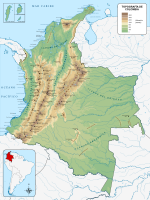Magdalena Valley dry forests
There are many endemic species, but much of the original habitat has been destroyed by agriculture and over-grazing, mainly by goats.
The valley floor is flat, with fertile alluvial soils and large deposits of ash from the Huila and Puracé volcanoes.
[3] The dry Tatacoa Desert holds many vertebrate fossils dating from the Miocene era.
[7] Annual rainfall in the Magdalena valley ranges from 831 to 2,268 millimetres (32.7 to 89.3 in), distributed over two distinct rainy seasons.
[10] In this model the dry pocket and surrounding forests are considered to be the Alto Magdalena Pleistocene refugium, a paleo-environment and a center of endemism.
The dry central pocket also includes umbrella-shaped woody species under 15 metres (49 ft) including Pithecellobium bogotense, Capparis odoratissima, Bulnesia carrapo, Maclura tinctoria, Fagara pterota, Parkinsonia aculeta, Prosopis juliflora and Vachellia farnesiana.
Endemic plant species include Steriphoma colombiana, Amaria petiolata and Pithecellobium bogotense.
[3] Endangered mammals include the white-footed tamarin (Saguinus leucopus) and the mountain tapir (Tapirus pinchaque).
Other endemic or endangered species from the humid forests of the foothills include the Colombian weasel (Mustela felipei).
Much of the original habitat has been destroyed by agriculture and overgrazing, particularly by goats, leaving only a few forest patches along creeks and the Cabrera River in Tolima Department.
[3] The population is poor, with limited education, often living in unhygienic conditions in shanty towns around large farms.
On flat soils that can be ploughed by tractor the most common type of farming is irrigated rice production, rotated with sorghum and cattle.
[2] Maps of the region from the early 21st century show about 31 irregular and fragmented remnants of dry forest, with an average size of 155.5 hectares (384 acres).



